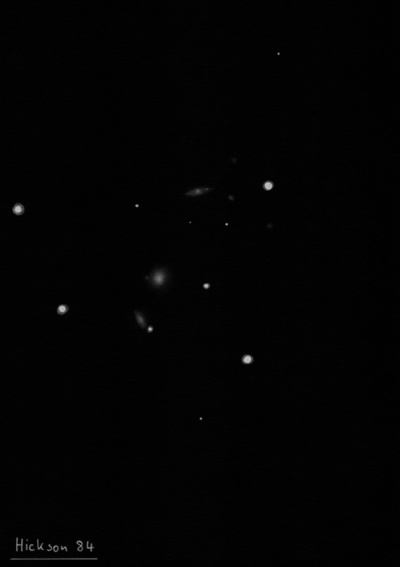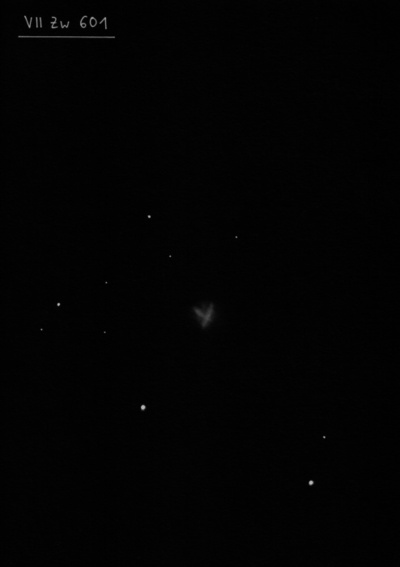A small constellation in the northern sky with the north pole less than one degree from Polaris. In this direction, the elongated axis of our planet is lost in the depths of space, and therefore the stars around the celestial pole can always be found in clear skies, because they are Circumpolar in our area. The constellation of the Ursa Minor itself is relatively inconspicuous and consists mainly of an outline consisting of seven stars, often called the Little Dipper. The two stars, Kochab and Pherkad, which form its rear wheels, are called the guardians of the pole. As the stars of the Little Dipper are mostly between the 2nd and 5th magnitude in brightness, and the constellation is always above the horizon at a greater or lesser height in the northern hemisphere, it may be used as a rough aid to ascertain the state of clearness of the sky. Indeed, if the stars δ, ε and ζ of Ursa Minor are not visible, the atmosphere is so opaque that we may not even identify the basic shape of the constellation. If the star η Umi (4.9mag) is not visible, conditions are too poor for serious observation of deep-sky objects. On the other hand, if it is visible from the suburbs or illuminated locations, then the atmospheric clarity is very good. From the countryside it should not be a problem to see even θ (5.2mag) and 19 Umi (5.5mag) on any average night. There are otherwise few interesting objects in the constellation. The most important of these is Polaris, the North Star, because of its proximity to the north celestial pole.
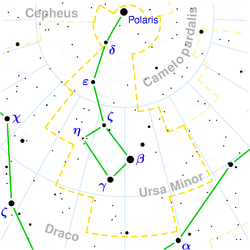
In dark skies, try to make your way to Polaris in the form of a 40-degree complex of physically related dark nebulae (called the Ling filament or Polaris loop). However, you need to start tracking it just northeast of Deneb, where the very dark Le Gentil 3 region is located. It clearly cuts into the Milky Way just off North America and transitions smoothly into its surroundings to the east. The complex then stretches west to the pair of stars α and β Cephei at the very edge of the Milky Way and extends further north to γ Cephei, where it loses much of its contrast due to the poorer stellar field. Leaving the Milky Way, the complex can be seen as a dark band in the sparse star field where it splits about five degrees north of the reflection nebula NGC 7023, in a star-poor spot about 6 by 4 degrees in size. One branch continues towards the pole (the area around Polaris itself is visually quite deficient in stars within a radius of 2-3 degrees), the other goes in the direction of a nameless fifth-magnitude star, where it fades out. Yes, there are indeed dark nebulae in the Little Dipper! Of course, the dark complex is not at all conspicuous and stands out the better the fainter stars are seen at the observing site. A similar dark serpentine extends towards Polaris from the eastern part of Cassiopeia, north of the double cluster h / χ Perseus. However, it is narrower, straighter and even less conspicuous. Observing dark nebulae is really fascinating, especially if you don't need any binoculars!
Polaris (α UMi) - Once known as the "leading star in the sky," it has another name - the North Star. In seas, deserts, and wastelands, it was the only indicator of the north in ancient times, before the invention of the compass. We can easily find it by drawing a line connecting the stars Merak and Dubhe, which form the back wheels of the Big Dipper, and extending it four times in the direction of the line. This will lead us to Polaris, which is located at the end of the handle of the Little Dipper.
Polárka (α UMi) - once known as the "leading star in the sky" has another name - the North Star. In seas, deserts, and wastelands, it was the only indicator of the north in ancient times, before the invention of the compass. We can easily find it by drawing a line connecting the stars Merak and Dubhe, which form the back wheels of the Big Dipper, and extending it four times in the direction of the line. This will lead us to Polaris, which is located at the end of the handle of the Little Dipper.
Pherkad (γ UMi) - The "Blue-White" second star of the Little Dipper, near which the orange star 11 Ursae minoris is located. The Arabs called it Pherkad - "two calves", later distinguishing between Pherkad Maior (3.05 mag) and Pherkad Minor (5.02 mag). They form only an optical double star, with their components being separated by 480 and 390 light-years, respectively.
η UMi - Optical double star, whose main white component is located 97 light-years away from us. When observing with the naked eye and a telescope, we can also see the second component of 19 Ursa Minor and its distant companion (magnitude 5.5), which is almost seven times further away from it.
π1 UMi - The binary star, with the primary component being yellow (6.6 mag) and the companion being white (7.3 mag), is located at a mutual distance of 31.1" and actually completes an orbit every 150 years. The stellar field around it is composed of a chain of relatively bright stars, forming a circle and an arc of three fainter stars.
NGC 6217
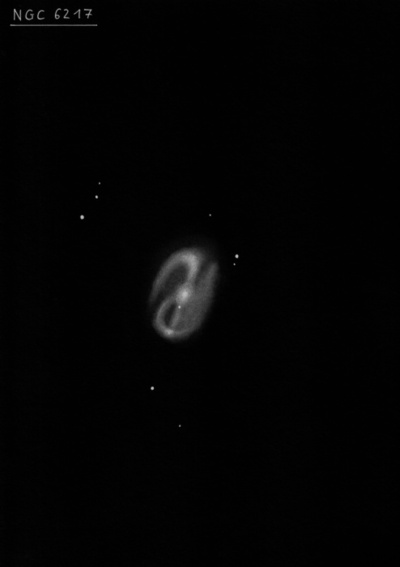
William Herschel discovered NGC 6217 = H I-280 on 12 Dec 1797 (sweep 1071) and logged "cB, cL, E, lbM. The extent points almost to 2 np pB stars, or rather a little on the following side of them. This is one of the later galaxies he discovered while searching in the far north to finish up his third catalogue. Hermann Kobold measured a very accurate micrometric position in 1892 with the 18-inch refractor at Strasbourg Observatory
200/250mm - 8" (8/24/84): faint, fairly small, slightly elongated.
300/350mm - 13" (8/24/84): fairly bright, slightly elongated, stellar nucleus, fairly diffuse outer halo.
400/500mm - 17.5" (7/22/01): fairly bright, fairly large, elongated 2:1 NW-SE, ~2.5'x1.5', small bright core. Contains a bright stellar nucleus. A very faint star is just off the NW edge. At the NW end a faint spiral arm is attached to the main body, winding north and then trailing back nearly halfway along the NE flank (this increases the dimensions to ~2.5'x2.0'). With concentration a dark gap is visible between the arm and the main body (bar) of the galaxy. A very short extension is strongly suggested at the SE end, bending towards the west. All of these features were sketched and later verified on the DSS.
17.5" (5/14/88): bright, fairly large, bright stellar nucleus, elongated. Irregular appearance; either darker or an indentation on one side (this is probably a gap between the spiral arms).
900/1200mm - 48" (10/22/11): at 375x, this beautiful, two-armed barred spiral spans ~2.3'x1.5' NNW-SSE. A bright central bar is well-defined, mottled and sharply concentrated with an intensely bright, very small nucleus. A mag 15 star is superimposed just SE of the nucleus. The bar contains a brighter, mottled patch at the NNW end. A long spiral arm is attached at this patch and wraps counterclockwise around the north and northwest side. A thinner second arm on the SSE side wraps around the south side towards the west.
Notes by Steve Gottlieb
NGC 3172
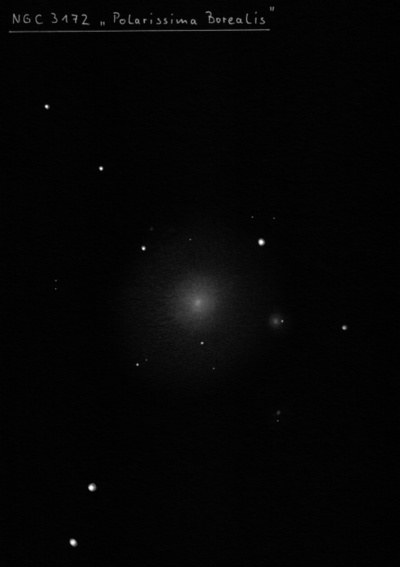
John Herschel discovered NGC 3172 = h250 on 4 Oct 1831 and recorded "vF; R; gbM; 25"; has a * 11m 2' S. This nebula is remarkable for its proximity to the pole. Owing to this the RA cannot be determined exactly, and the PD is open to correction." In the synonym column he called it "Polarissima" but later it was called "Polarissima Borealis" to distinguish it from "Polarissima Australis". Heinrich d'Arrest observed it with the 11" refractor at Copenhagen on 12 Aug 1866. He noted the mag 12 star is 75" distant to the north. At the time of discovery in 1831 this galaxy was only 4.5' from the north celestial pole!
400/500mm - 17.5" (7/16/93) : faint, very small, round, 0.5' diameter, very small brighter core, faint stellar nucleus. A mag 13 star is 1.5' NW. This is the closest NGC galaxy to the North Celestial Pole and is known as "Polarissima Borealis".
17.5" (11/14/87): very faint, small, round, brighter core, faint stellar nucleus, can hold steadily with averted. A mag 12.5 star is 1.5' distant.
17.5" (8/1/86): faint, brighter core, fairly small, round. A mag 13 star is within 2'.
600/800mm - 24" (9/6/18): at 375x; fairly faint, fairly small, round, 30" diameter, very small brighter core that occasionally sharpens up to a quasi-stellar nucleus. A mag 12.5 star is 1.5' (NW). MCG +15-01-010, situated just 1.5' (WSW), appeared extremely faint, very small, round, 18" diameter, low even surface brightness.
24" (9/15/12): fairly faint, small, round, 25" diameter, well defined halo, broad weak concentration with a very small brighter nucleus. A mag 13 star is 1.5' distant (NW) and a very faint mag 16.5 star is 50" S.
900/1200mm - 48" (10/26/16): at 375x and 488x; fairly bright, moderately large, round. Sharply concentrated with a very bright round core that increases to the center and a low surface brightness 45" halo. A mag 12.5 star is 1.5' separation (NW) and a mag 16-16.5 star is within 1' (50" S).
MCG +15-01-010, at 1.6' separation (WSW), appeared fairly faint, fairly small, ~35" diameter, slightly elongated, weak concentration. Visible continuously with direct vision though fairly low surface brightness. A mag 16.7 star is 16" W at the edge of the halo. 2MASX J11503836+8907109, at 1.8' separation (NNE), appeared extremely faint and small, ~6" diameter. A mag 15.7 is 25" away. At 610x, the galaxy popped as a thin, low surface brightness edge-on, ~20"x6".
Notes by Steve Gottlieb
NGC 5144
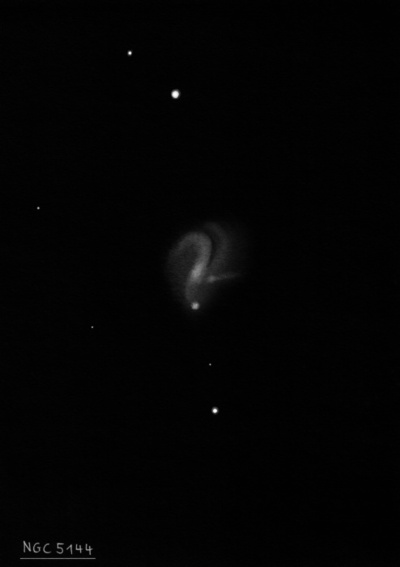
William Herschel discovered NGC 5144 = H IV-70 on 6 May 1791 (sweep 1005) and recorded "pB, R, almost equally bright throughout, resembling a very ill defined planetary nebula, about 0.5' diameter." Classified by Herschel in category IV (planetary nebula).
400/500mm - 18" (6/21/03): fairly faint, slightly elongated, fairly small, 0.8'x0.7'. Broad, weak concentration. Five or six mag 11.5-12 stars are in the field with the closest 1.9' N. Located 25' NW of mag 7.4 SAO 7817.
600/800mm - 24" (6/4/16): at 375x; moderately bright, irregularly round, fairly small, 0.7'x0.6', mottled or uneven surface brightness but no distinct core. Situated at the midpoint of a mag 11.8 star 1.9' NNW and a mag 13.7 2.0' SSW.
NGC 5144 apparently has a merged companion at the south edge, identified as NGC 5144 NED01 = LEDA 200298. It appeared as a quasi-stellar knot (less than 6" diameter) at the south edge of the halo, just 18" from the center of the main galaxy!
Notes by Steve Gottlieb
NGC 6068
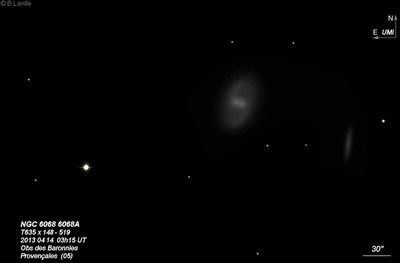
Forms a close pair with NGC 6068A 2.0' WSW. The companion appeared faint, small, elongated 2:1 N-S, brighter core. Can hold steadily with direct vision. Located along the south side of a small triangle of mag 13-14 stars.
William Herschel discovered NGC 6068 = H III-973 on 6 Dec 1801 (sweep 1104) and recorded "vF; S; lE in the meridian [N-S], r." His position is 2.3' south-southeast of UGC 10126, though he missed NGC 6068A.
400/500mm - 17.5" (5/14/88): moderately bright, moderately large, slightly elongated, small bright core. Follows a triangle of mag 13-14 stars 0.8' SSW, 1.3' NW and 2.5' WSW.
Notes by Steve Gottlieb
